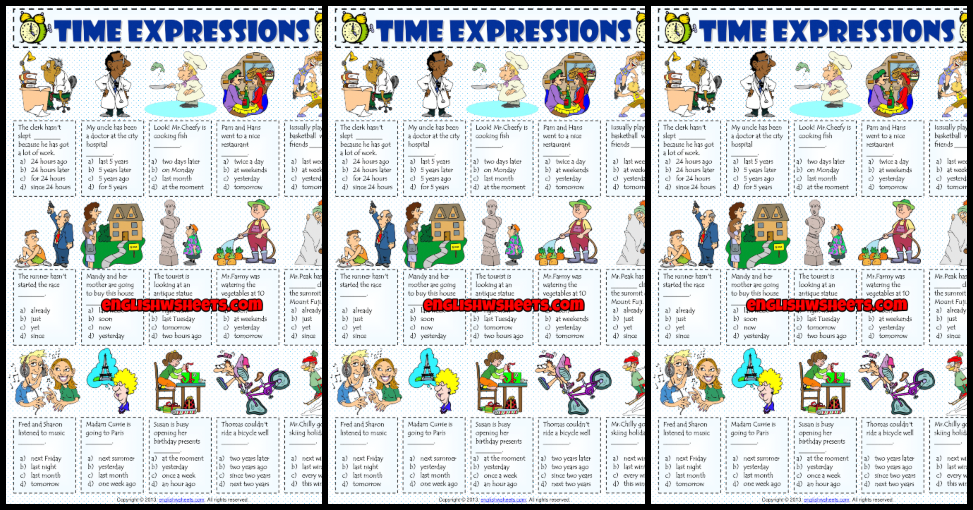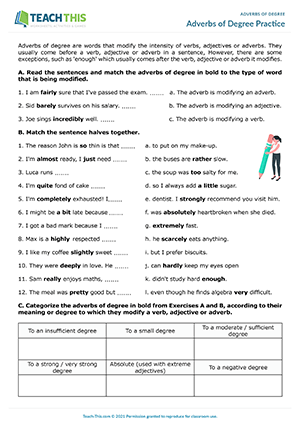Adverbs Of Time Exercises : Adverbs Of Manner Time Place And Frequency Exercises Exercise Poster : Today, yesterday, in the afternoon, last night, last week, last year, two months ago, already, soon, still, finally, weekly, daily, every year, monthly etc.
Adverbs Of Time Exercises : Adverbs Of Manner Time Place And Frequency Exercises Exercise Poster : Today, yesterday, in the afternoon, last night, last week, last year, two months ago, already, soon, still, finally, weekly, daily, every year, monthly etc.. She stayed at her grandmother's house all day. Adverb of time worksheet exercises for class 3 with answers cbse pdf. Adverbs of time that express an exact number of times the action happens usually work best at the end of a sentence. How come how many how often a) how come b) how many c) how often. Adverbs of time show when an event occurred.
You can do this quiz online or print it on paper. End of the free exercise to learn english: Adverbs of time describing for how long an action occurred usually work best at the end of a sentence. Many adverbs of time are the same as adverbs of frequency. Adverbs of time place manner and frequency worksheets.

Answer the following questions as per the story.
Adverbs of place come after the verb; 1143 adjective or adverb exercise 5 elementary. We live in glasgow (now). Full list with examples & exercises. In this adverbs of time interactive worksheet, students learn and practice definite time adverbs related to points of time. And 2) a brief writing exercise using adverbs of. An adverb is a word that describes a verb, or action word. Adverbs of frequency show how often an action is done. Adverbs of time are usually placed at the end of a sentence. Adverbs of time describing for how long an action occurred usually work best at the end of a sentence. Adverbs of time show when an event occurred. An adverb of time tells us when or _____ the action occurs. Once done refer to the answers provided in the end of the exercise and check your progress.
English as a second language (esl) order results: Un (court) verre entre amies; The adverb clause connectors, such as after, before, when, while/as, by the time, since, until/till, as soon as/once, as long as/so long as, and whenever can be used to form adverb clauses of time. Answer the following questions as per the story. This worksheet consist of two exercises, 1) matching the correct adverb in the sentence;

You can do this quiz online or print it on paper.
Adverbs of time are usually placed at the end of a sentence. Now, today, daily, early and soon are all adverbs of time. Once done refer to the answers provided in the end of the exercise and check your progress. Recently, now, then, yesterday) adverbs of time are usually put at the end of the sentence. A free english exercise to learn english. Today, yesterday, in the afternoon, last night, last week, last year, two months ago, already, soon, still, finally, weekly, daily, every year, monthly etc. If there is no object in the sentence, the adverb of manner comes after the verb. Adverb of time worksheet exercises for class 3 with answers cbse pdf. Adverbs of time tell us when something happens. Some of the worksheets below are adverbs of time place manner and frequency worksheets : These adverbs can describe how often, how long or when something takes place. Position of adverb in a sentence. 1133 adjective or adverb exercise 3 intermediate.
There is quite a bit of overlap between these two types of adverbs. You can do this quiz online or print it on paper. This allows students students to demonstrate their understanding of adverbs of time, place and manner. Adverbs of time examples in the following sentences are in bold for easy identification. How come how many how often a) how come b) how many c) how often.

Adverbs of time show when an event occurred.
How to use during / for / while. Adverbs of time can be placed at the end or the beginning of a sentence. Adverbs of time, while seemingly similar to adverbs of frequency, tell us when something happens. A free english exercise to learn english. Most popular first newest first. Adverbs clause of time worksheet with solved answers. Here, the preposition is a part of the verb (phrasal verb) the students listened (attentively) →. You can do this quiz online or print it on paper. Full list with examples & exercises. Adverbs of frequency show how often an action is done. •yet shows that we expect some action to take place in the future.it is used in yes/no questions and negative statements at the end of the sentence. Adverbs of place come after the verb; Try completing the given sentences first on your own, using adverbs of time to fill the blanks.
If you don't want to put emphasis on the time, you can also put the adverb of time at the beginning of the sentence adverbs of time. These adverbs can describe how often, how long or when something takes place.